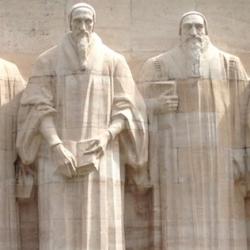Irene Dingel’s contribution to Lutheran Ecclesiastical Culture, 1550-1675 examines the role of controversy in the formation of Lutheran theology and practice. She examines several early intra-Lutheran controversies, among them the contest between the Gnesio-Lutherans led by Matthias Flacius and the “Philippists” led by Melanchthon. The former accused the latter of compromise and abandonment of the Reformation gospel. Overtly doctrinal and practical questions came into dispute, but sub-doctrinal questions of theological method and convictions about ritual were equally important.
The Gnesio-Lutherans produced their own Jena edition of Luther’s works, which had already been published in Wittenberg. The two editions followed different formats that reflected different approaches to Luther’s theology and to the uses of theological authorities in general: “The Wittenberg Edition followed a topical method of arrangement to enable readers to survey quickly the reformer’s opinions on specific theological questions; the Jena Edition presented his writings in simple chronological order. This served to prevent a false use of Luther as a reformational authority which ignored the historical development of his thought and its context.” Dingel adds that “The Gnesio-Lutherans believed that their opponents misused Luther’s words, taking them out of proper context, to legitimize their positions, and reproached them for reckless abandonment of the heritage of the Reformation under the influence of Albertine policy while appealing to Luther at the same time” (26).
Convictions about ritual also ran through the dispute. Melanchthon’s main concern was to preserve the true teaching of the gospel, and regarded many rituals as “neutral.” Flacius’s position was more “anthropological” and contextual: In themselves, rituals may be adiaphora, but Flacius posited a “distinction between true and false adiaphora in cases where confession is necessary, based on whether they preserved or sacrificed Christian freedom” (32). Thus, he “could envision situations in which an adiaphoron could become a testimony for or against the gospel” (37). In such cases, the rites were not neutral, but a matter of faithful confession. In Flacius’s words, “In the case where confession of the faith is necessary there are no adiaphora” (nihil est adiaphoron in casus confessionis et scandali; 37). In particular, “Adiaphora cease to be neutral and free when they are prescribed and introduced with coercion. Then they divert the focus of the faithful from God’s true Word and irresponsibly refocus on the so-called adiaphora” (37).
Dingel describes Flacius’s view of confession as a “holistic” one; it is what I mean by “anthropological”: “Flacius and his comrades held a holistic view of confessing. Confession extends beyond faith and doctrine; ceremonies and liturgical ritual also convey the church’s teaching. . . . Melanchthon and his circle defined confessing and confession strictly in terms of doctrinal content and focused it on a certain ‘summa doctrinae’” (38).
This difference regarding ceremonies and rites had political consequences: “Because Melanchthon presumed a clear division between doctrine and external ceremonies, he could permit the government to intervene in matters of the church’s external order. That would not impact existentially decisive questions of doctrine. For Flacius the fundamental question was different. He relativized the division between teaching and ceremonies; in so far as this distinction can be realized in reality, the specific situation determines whether ceremonies convey proper teaching” (38). Flacius advocated an ordered, structured church life, but he did not think it was the state’s business to establish or regulate it (39).
As is often the case, the most important issues in dispute are not always on the surface. They may not surface at all, since they are sub-systematic rather than systematic.










